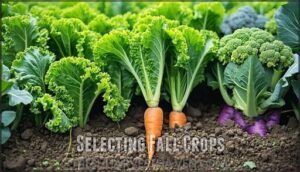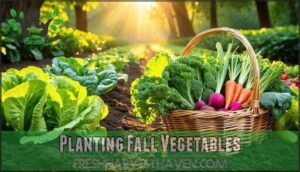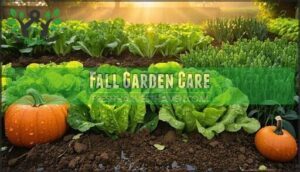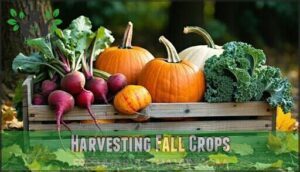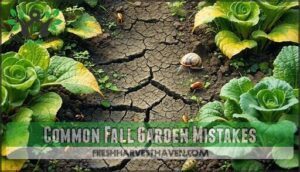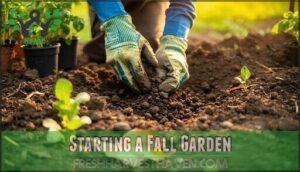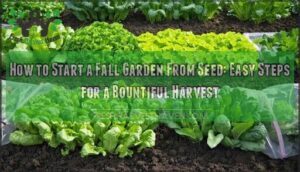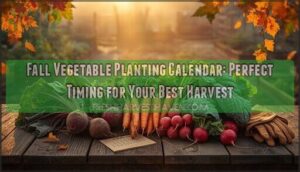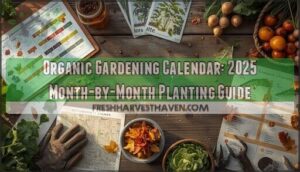This site is supported by our readers. We may earn a commission, at no cost to you, if you purchase through links.
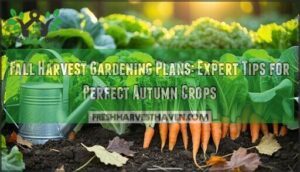 Your fall harvest gardening plans start with knowing your first frost date, which acts like a countdown timer for your autumn crops.
Your fall harvest gardening plans start with knowing your first frost date, which acts like a countdown timer for your autumn crops.
You’ll want to choose cold-tolerant vegetables like kale, carrots, and Brussels sprouts that actually taste sweeter after a light frost.
Count backward from your frost date using each crop’s maturity timeline to nail your planting schedule. Clear spent summer plants, add compost, and sow seeds about 10-12 weeks before hard frost hits.
Think of fall gardening as nature’s second chance – cooler weather means fewer pests and less watering stress. The secret timing tricks can make or break your harvest success.
Table Of Contents
- Key Takeaways
- Fall Garden Planning
- Selecting Fall Crops
- Planting Fall Vegetables
- Fall Garden Care
- Harvesting Fall Crops
- Common Fall Garden Mistakes
- Starting a Fall Garden
- Frequently Asked Questions (FAQs)
- When should I start planting for fall harvest?
- What gardening should be done in the fall?
- What is the most common fall harvest?
- What root vegetables can you harvest in the fall?
- How do you plan a fall garden?
- Can you plant vegetables in a fall garden?
- What crops are best for fall gardens?
- When should you start planting for a fall harvest?
- What can I put in my Garden in the fall?
- How do you prepare for fall harvest?
- Conclusion
Key Takeaways
- Calculate your planting timeline by working backward from your first frost date – You’ll need to count back 10-12 weeks from your area’s expected first frost, adding extra time since fall crops grow slower in cooler temperatures.
- Choose cold-tolerant vegetables that actually improve after frost exposure – You’ll get the best results with crops like kale, carrots, Brussels sprouts, and parsnips that develop sweeter flavors when temperatures drop.
- Prepare your garden beds properly before planting – You’ll need to clear spent summer plants, add 2-4 inches of compost to enrich the soil, and ensure proper drainage for your fall crops to thrive.
- Use succession planting and smart timing to extend your harvest – You’ll maximize your fall garden by planting fast-growing crops like radishes and lettuce every two weeks, while giving slower crops like root vegetables time to mature before the hard frost hits.
Fall Garden Planning
You’ll need to determine your area’s first frost date and work backward to calculate when each crop should go in the ground, since fall vegetables require precise timing to mature before winter arrives.
Master fall timing or watch months of garden dreams disappear with the first unexpected frost.
Start by clearing spent summer plants and enriching your soil with compost, then select cold-hardy varieties that actually improve in flavor after exposure to frost, such as kale, carrots, and Brussels sprouts.
Determining First Frost Date
Your garden’s success starts with pinpointing your first frost date—that pivotal autumn morning when temperatures plummet to 32°F or below.
Frost date averages provide a baseline, but microclimate variations can shift timing by weeks. Check historical frost data and local weather patterns rather than relying solely on zone hardiness impact maps.
Here’s what makes frost dates emotionally vital for your fall gardening dreams:
- They determine whether your harvest vegetables will survive or perish
- Missing this date means losing months of hard work
- Getting it right guarantees bountiful fall planting guide success
- Your family’s winter meals depend on accurate timing
- First frost date knowledge separates novice from master gardeners
However, gardeners should note that freeze dates are changing due to climate change.
Choosing Suitable Vegetables
Once you’ve pinned down your frost date, selecting the right harvest vegetables becomes your ticket to fall garden planning success.
Smart crop choices match your climate considerations while maximizing your growing window.
Fall gardening rewards patience with vegetables that taste better after kissing frost than summer ever could.
Cool-season champions like spinach and kale actually improve after frost exposure, developing complex flavor profiles that summer heat can’t deliver.
Quick-maturing varieties like radishes give you results in just 25 days, perfect when time’s running short.
Consider these top performers for your fall planting guide:
- Root vegetables (carrots, beets) develop incredible sweetness in cool weather
- Leafy greens (lettuce, arugula) offer continuous harvests with proper succession planting
- Brassicas (broccoli, cabbage) provide excellent disease resistance and cold tolerance
- Fast-growing herbs (cilantro, parsley) thrive in fall’s moderate temperatures
- Storage crops (garlic, onions) adapt well to various soil preferences
Space requirements vary substantially between compact lettuce and sprawling Brussels sprouts, so plan accordingly for your best fall vegetables.
Preparing Garden Beds
Before you plant your autumn treasures, transforming tired summer beds into productive spaces requires methodical garden bed preparation. Start with thorough weed removal, clearing spent crops that rob nutrients from incoming plants.
Soil preparation involves adding two inches of organic compost across each bed, boosting soil health naturally. Test pH levels, making adjustments as needed.
Soil amendments like aged manure work wonders in raised beds. Finally, improve drainage improvement and compost application guarantees your fall garden preparation sets the stage for abundant harvests.
To further enrich the soil, consider adding aged manure for increased fertility.
Selecting Fall Crops
You’ll want to focus on vegetables that actually enjoy cooler weather, since fall’s dropping temperatures create perfect conditions for crops like kale, carrots, and broccoli that become sweeter after frost.
Choose varieties with maturity dates that fit your timeline, prioritizing quick-growing options like radishes and spinach alongside slower crops that can handle a light freeze.
Cold-Tolerant Vegetables
Smart gardeners know that cold-tolerant vegetables become the true champions of fall gardening, transforming chilly weather into sweet advantages.
These hardy brassicas and overwintering greens actually celebrate frost’s arrival, developing enhanced flavors that summer crops can’t match.
Cool season crops like kale, carrots, and Swiss chard don’t just survive—they thrive when temperatures drop.
Fall alliums and cold climate herbs round out your autumn arsenal perfectly.
- Kale survives down to 5°F while gaining frost sweetness
- Carrots develop candy-like flavors after cold exposure
- Swiss chard produces colorful stems throughout winter months
- Leeks withstand bone-chilling temperatures down to 0°F
Your fall harvest depends on choosing vegetables that embrace winter’s kiss rather than fear it.
Fast-Maturing Crop Varieties
Beyond cold tolerance, timing becomes your secret weapon for fall harvest gardening plans. Quick radishes sprint to maturity in 25 days, while speedy spinach reaches harvest size within 30 days. Fast lettuce varieties like ‘Black Seeded Simpson’ deliver crisp leaves in just 45 days.
These crops benefit from solar energy collection due to their broad leaves.
| Crop | Days to Maturity | Best Varieties |
|---|---|---|
| Early arugula | 21-30 days | ‘Astro’, ‘Rocket’ |
| Rapid mustard | 25-35 days | ‘Red Giant’, ‘Mizuna’ |
| Swiss chard | 30-40 days | ‘Bright Lights’, ‘Fordhook’ |
These fast growing vegetables maximize your shortened autumn window, ensuring abundant harvests before frost arrives.
Root Crops for Fall Harvest
Your fall gardening success hinges on choosing root vegetables that actually improve with cold weather.
These underground treasures undergo a natural sweetening process as frost arrives, transforming starches into sugars for incredible flavor.
- Carrots develop candy-like sweetness through proper variety selection and soil preparation
- Beets store beautifully all winter while resisting most pest control issues
- Parsnips become remarkably sweet after experiencing several hard frosts
- Turnips offer dual harvests with both roots and greens thriving in cool conditions
- Radishes provide quick satisfaction with winter storage varieties lasting months
Planting Fall Vegetables
Once you’ve selected your fall crops, you’ll need to master the timing and techniques that guarantee successful autumn harvests.
The key lies in calculating precise planting dates, using direct sowing methods effectively, and implementing succession planting strategies that provide continuous yields until winter arrives.
Direct Sowing Seeds
Direct sowing transforms your fall gardening success when you master the fundamentals.
Check soil temperature first—warm autumn earth beats cold spring conditions for faster germination rates. Plant fall seeds at proper seed depth (usually twice the seed’s width) and press firmly for good contact.
You can find various options for fall seeds online. Establish a consistent watering schedule to maintain moisture without waterlogging.
Choose varieties with proven viability and quick sprouting times. These planting techniques give your crops the strongest foundation, while proper thinning seedlings prevents overcrowding as they develop.
Succession Planting Strategy
Once you’ve mastered seed starting, succession planting becomes your secret weapon for extending the fall harvest season.
This staggered planting approach guarantees continuous harvest from your autumn garden through strategic crop rotation and careful timing of maturity timelines.
Here’s your succession planting blueprint for fall garden planning:
- Plant lettuce every two weeks – Fresh greens until the first hard frost
- Stagger radish varieties – Quick-growing crops provide weekly harvests
- Schedule spinach sowings – Cool-weather champions thrive in autumn conditions
- Rotate bean plantings – Extend season with multiple harvests before cold arrives
- Time carrot succession – Sweet roots mature throughout your harvest window
Calculating Planting Dates
Perfect timing transforms autumn gardening dreams into reality. Master these frost date math calculations to create your fall harvest schedule that delivers consistent results.
Here’s your step-by-step approach:
- Find your first frost date using local weather data or extension office resources
- Check seed packet details for days to maturity (DTM) information
- Add 14 days to account for shorter daylight and cooler temperatures
- Count backward from frost date to determine your planting dates
This calculation accounts for fall growth rates and maturity timeframes in your region. Zone-specific dates vary substantially, so consult local extension offices for precise fall garden planning.
Succession timing becomes vital when you’re working backward from that first frost deadline—there’s no wiggle room for late starts in autumn gardening.
Fall Garden Care
Your fall vegetables won’t thrive on autopilot, so you’ll need to maintain consistent watering schedules and monitor soil moisture as temperatures drop and growth patterns shift.
Smart mulching techniques and regular soil checks will help your crops develop the sweet, frost-kissed flavors that make autumn gardening worthwhile, with consistent attention to these details.
Consistent Watering Techniques
Your fall crops need steady moisture like a gentle rain rather than feast-or-famine watering sessions.
Check soil daily by poking your finger two inches down—dry means it’s watering time.
Adjust your watering frequency based on soil type and weather patterns. Clay holds moisture longer than sandy ground.
Container watering requires more attention since pots dry faster.
Deep, infrequent irrigation scheduling prevents drought stress while promoting robust root systems that’ll weather autumn’s temperature swings.
Mulching for Moisture Retention
While watering keeps your plants hydrated, mulch works as your garden’s moisture-saving superhero. You’ll want to spread organic materials like straw, shredded leaves, or bark chips around your plants with the right Application Depth of 2-3 inches.
Mulch keeps your garden thriving by locking in moisture, controlling weeds, and protecting roots during cooler fall days.
Different Mulch Types serve unique purposes in your autumn garden. Compost enriches soil while breaking down, whereas bark chips provide lasting coverage for fall garden maintenance. This protective layer reduces Watering Frequency by maintaining consistent soil moisture and Soil Temperature. Optimal mulch depth is essential for effectiveness.
Mulch keeps your garden thriving by locking in moisture, controlling weeds, and protecting roots during cooler fall days.
Beyond water retention, you’ll appreciate the excellent Weed Suppression that saves hours of tedious work. These mulches create a barrier that prevents weeds from stealing nutrients and water from your precious fall crops, working tirelessly to support your harvest success.
Monitoring Soil Moisture Levels
Consistency becomes your garden’s best friend when monitoring soil moisture levels throughout fall.
Your finger works as nature’s moisture meter – stick it 2-3 inches deep to feel actual dampness, not surface dryness.
Soil moisture sensors offer precise readings if you prefer digital accuracy over the finger test.
- Watch for drainage issues that create waterlogged spots where roots can’t breathe
- Recognize underwatering signs like wilted leaves during cool morning hours
- Adjust irrigation scheduling based on each crop’s water retention needs
Smart watering practices prevent both overwatering risks and drought stress in your autumn harvest.
Harvesting Fall Crops
You’ll know your fall crops are ready when they’ve reached full size and developed their characteristic colors, though many vegetables actually taste better after experiencing a light frost.
Harvest root vegetables like carrots and parsnips after cold weather sweetens them, while leafy greens can be picked continuously as outer leaves mature, ensuring you get the most flavor and nutrition from your autumn garden.
Timing for Optimal Flavor
Two weeks after your first frost date, you’ll activate frost sweetening magic in your fall garden vegetables.
Cold transforms starches into sugars, making carrots taste like candy and kale lose its bitter edge.
Track maturity dates closely—harvest windows extend beyond summer’s rigid schedules.
Smart variety selection guarantees flavor development peaks when frost timing aligns perfectly with your harvest season planning.
Storage Methods for Fall Harvest
Your fall harvest deserves proper storage to enjoy fresh vegetables through winter. Root cellaring transforms basements into natural refrigerators—store carrots, beets, and turnips in damp sand at 32-40°F with high humidity.
Freezing produce works perfectly for leafy greens after blanching, while canning techniques preserve pickled vegetables and sauces. Dehydrating methods concentrate flavors in herbs and tomatoes, and fermentation options create tangy sauerkraut or kimchi.
To guarantee safety with canning, always follow tested recipes and processing times.
Smart winter storage starts with proper preparation and consistent monitoring:
- Imagine carrots nestled in cool, moist sand like they’re sleeping until spring
- Picture mason jars lined up like soldiers, filled with colorful preserved vegetables
- Visualize your freezer stocked with bright green kale, ready for winter smoothies
- See dried herb bundles hanging like fragrant decorations in your pantry
Success in preserving vegetables depends on maintaining proper temperatures and checking stored produce weekly.
Using Fall Crops in Recipes
Your fall garden crops deserve culinary treatment that showcases their peak flavors. Transform harvesting fall vegetables into cozy autumn meals with these proven techniques.
Create Root Vegetable Recipes by roasting carrots and parsnips until caramelized. Develop Brassica Side Dishes using Brussels sprouts and cauliflower. Craft Fall Greens Salads with massaged kale and arugula.
Enhance dishes with Garlic Infused Oils and Herb Seasoning Blends from your fall harvest.
Common Fall Garden Mistakes
Even experienced gardeners can stumble when shifting from summer to fall crops, often overlooking key steps that make the difference between a thriving harvest and disappointing results.
You’ll avoid these common pitfalls by checking your soil pH, providing proper plant support, and planning ahead for seasonal pest challenges that can quickly derail your autumn garden, including seasonal pest challenges.
Forgetting to Check Soil PH
Perfect timing for your fall harvest gardening plans—but skipping soil pH testing is like cooking without tasting your food.
You’ll wonder why your vegetables look miserable despite perfect care. When pH levels drift outside the 6.0-7.0 sweet spot, nutrient availability plummets.
Your plants can’t absorb what they need, no matter how much you fertilize. Testing frequency should happen every 2-3 years, but many gardeners forget entirely.
Garden soil testing reveals the real story behind struggling crops:
- Acidic soil (below 6.0) locks up phosphorus and calcium
- Alkaline soil (above 7.5) blocks iron and manganese uptake
- Correcting imbalances takes weeks, so test before planting
Optimal levels mean amending soil becomes strategic, not guesswork. Your pH impact determines everything.
Not Providing Adequate Support
Skipping proper plant support is like building a house without a foundation—everything comes crashing down when storms hit. Your fall crops need sturdy support systems to withstand autumn’s unpredictable weather and heavy harvests.
Install garden supports at planting time, not when plants start leaning. Tall Brussels sprouts and heavy cauliflower heads require strong staking techniques, while sprawling kale benefits from cage construction.
Consider your plant support needs carefully: wind damage destroys unsupported crops faster than frost. One common mistake is leaving soil bare, which can lead to erosion around the base of your supported plants.
Garden trellises and vertical gardening maximize space while protecting vulnerable stems. Choose the right support type early—your harvest depends on it.
Failing to Plan for Pest Control
Pest identification becomes your first line of defense when cabbage worms attack your Brussels sprouts.
You’ll need preventative measures like row covers and strategic crop rotation to break pest cycles.
Plant marigolds to attract beneficial insects that eliminate aphids naturally.
When problems arise, organic solutions like neem oil provide effective fall garden pest management without harming your harvest.
Consider seasonal pest products for thorough protection.
Starting a Fall Garden
You’ll need to clear out spent summer plants and refresh your soil with 2-4 inches of compost before planting your fall crops.
This preparation sets the foundation for a productive autumn garden, as cooler temperatures and nutrient-rich soil help fall vegetables establish strong root systems before winter arrives, which is crucial for a successful autumn garden.
Clearing Summer Crops
Your summer garden’s curtain call has arrived, and it’s time to clear the stage for your fall harvest stars. Garden cleanup transforms chaos into opportunity, creating prime real estate for autumn crops while breaking pest and disease cycles that threaten your fall garden success.
Start your soil preparation by pulling spent summer crops completely—roots and all. Stubborn roots? Cut stems at soil level and let underground portions decompose naturally. Rake away fallen leaves and debris that become winter hideouts for unwelcome guests, supporting effective pest management.
Compost piles welcome healthy plant material, but diseased specimens belong in the trash to protect future harvests. To enrich the soil, consider adding dried kelp fertilizer to the planting area.
This methodical approach sets the foundation for successful crop rotation and preparing for winter growing seasons ahead.
- Clear pathways between beds for easy access during cool-weather maintenance
- Remove plant stakes and supports to prevent winter weather damage
- Check tool maintenance needs while equipment is readily accessible
- Mark problem areas that need extra attention next season
- Document which varieties performed best for future planning
Adding Compost and Amendments
Once you’ve cleared your summer crops, it’s time to give your soil the royal treatment it deserves. Soil testing reveals what your garden actually needs—no guesswork required.
Mix four inches of well-aged compost with your existing soil, creating the perfect foundation for fall vegetables.
Amendment timing matters more than you’d think. Apply organic matter at least two weeks before planting, allowing nutrients to integrate properly.
This soil preparation transforms tired earth into a nutrient powerhouse.
| Compost Types | Best Uses | Application Rate |
|---|---|---|
| Aged manure | Heavy feeders | 2-3 inches |
| Leaf mold | Clay soils | 1-2 inches |
| Kitchen scraps | General purpose | 3-4 inches |
Local resources often provide bulk compost at reasonable prices. Your garden soil feeding strategy sets the stage for exceptional autumn harvests.
Using Space Efficiently for Fall Crops
Maximizing your fall garden space requires strategic thinking and smart techniques.
Vertical gardening lets you grow up instead of out, while intercropping methods squeeze more plants into existing beds.
Container gardening works perfectly for quick crops like lettuce.
Use square foot gardening principles and companion planting to maximize yields.
Succession planting keeps harvests coming all season long.
Frequently Asked Questions (FAQs)
When should I start planting for fall harvest?
Timing’s absolutely everything!
You’ll want to start planting 8-12 weeks before your first expected frost date.
Count backward from that magical frost deadline, then get those cool-season seeds in the ground for perfect fall harvests.
What gardening should be done in the fall?
Plant cool-season crops like kale, spinach, and carrots in September through November.
Clear spent summer plants, refresh soil with compost, and use row covers for frost protection to extend your growing season.
What is the most common fall harvest?
Root vegetables like carrots, beets, and turnips dominate most fall harvests.
You’ll also find leafy greens such as kale, spinach, and lettuce thriving in cooler weather, delivering sweeter flavors after frost.
What root vegetables can you harvest in the fall?
Underground treasures await your autumn harvest.
You’ll discover carrots, beets, turnips, radishes, and parsnips sweetened by frost.
These hardy vegetables store well, providing fresh nutrition throughout winter months when properly harvested and stored.
How do you plan a fall garden?
Start by learning your first frost date, then count backward from that date based on each crop’s maturity time.
Choose cold-hardy vegetables, prepare soil with compost, and sow seeds at proper intervals.
Can you plant vegetables in a fall garden?
Picture crisp autumn air filling your lungs as you harvest sweet carrots and tender kale from your thriving fall garden.
You’ll absolutely plant vegetables in fall – cool-season crops like spinach, broccoli, and radishes flourish in cooler temperatures.
What crops are best for fall gardens?
Cool-season champions like kale, spinach, and carrots thrive in fall’s crisp conditions. You’ll love how radishes, lettuce, and broccoli handle frost beautifully, while garlic planted now rewards you next summer.
When should you start planting for a fall harvest?
Most gardeners miss the golden window: you’ll need to start planting 10-12 weeks before your first frost date.
Count backward from that date, adding extra time since fall growth slows in cooler temperatures.
What can I put in my Garden in the fall?
You can plant cool-season crops like kale, spinach, carrots, radishes, lettuce, broccoli, and garlic in fall. These vegetables thrive in cooler temperatures and often taste sweeter after frost exposure.
How do you prepare for fall harvest?
Calculate your first frost date, then work backward to determine planting times.
Clear spent summer crops, refresh soil with compost, and choose fast-maturing, cold-hardy varieties like spinach and radishes for success.
Conclusion
Summer’s blazing heat gives way to autumn’s gentle embrace, creating perfect conditions for your fall harvest gardening plans.
You’ve learned the essential timing strategies, from calculating frost dates to selecting cold-hardy varieties that thrive in cooler weather.
Remember, fall gardening isn’t just about extending your growing season—it’s about discovering vegetables that taste better after frost kisses them.
Start planning now, and you’ll be harvesting crisp carrots and sweet Brussels sprouts when neighbors’ gardens lie dormant.
- https://extension.okstate.edu/fact-sheets/fall-gardening.html
- https://www.almanac.com/soil-preparation-how-do-you-prepare-garden-soil-planting
- https://extension.uga.edu/publications/detail.html?number=AP105&title=fall-gardening-a-collection-of-information-and-resources
- https://home.howstuffworks.com/starting-a-vegetable-garden.htm
- https://www.thrivelot.com/resources/how-to-plan-crops-for-extended-harvest


